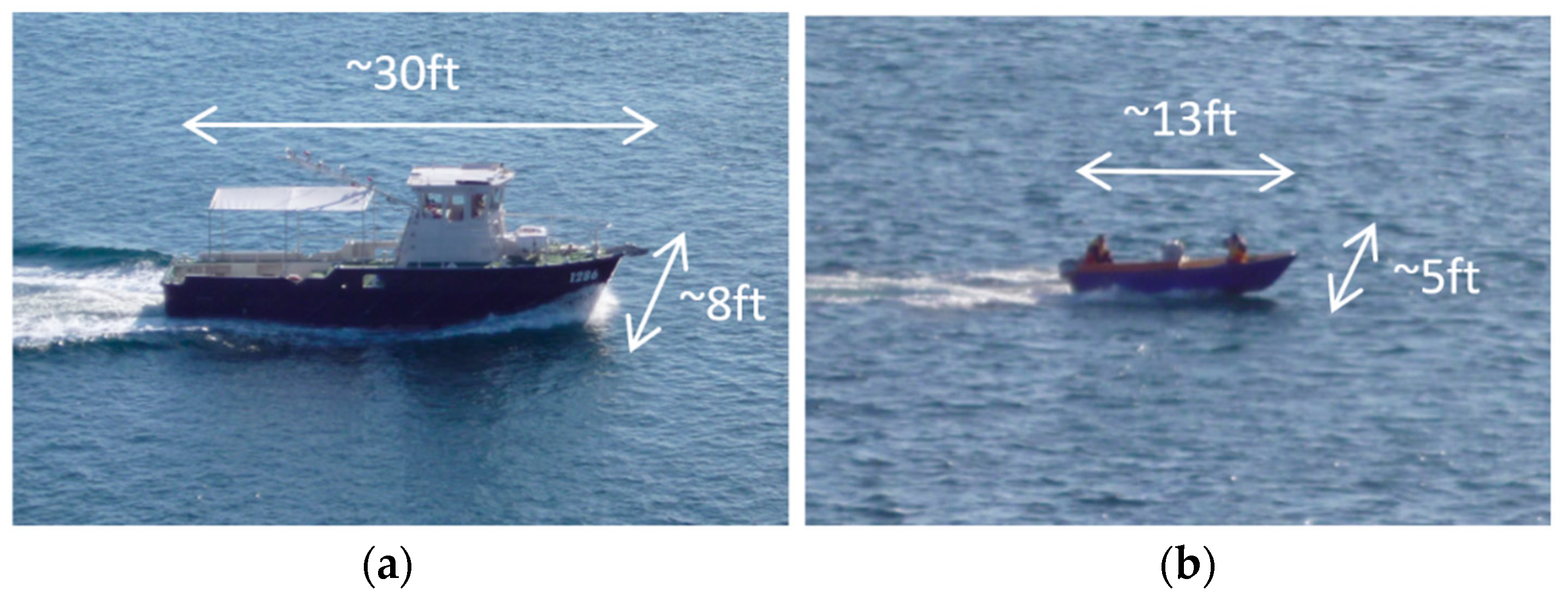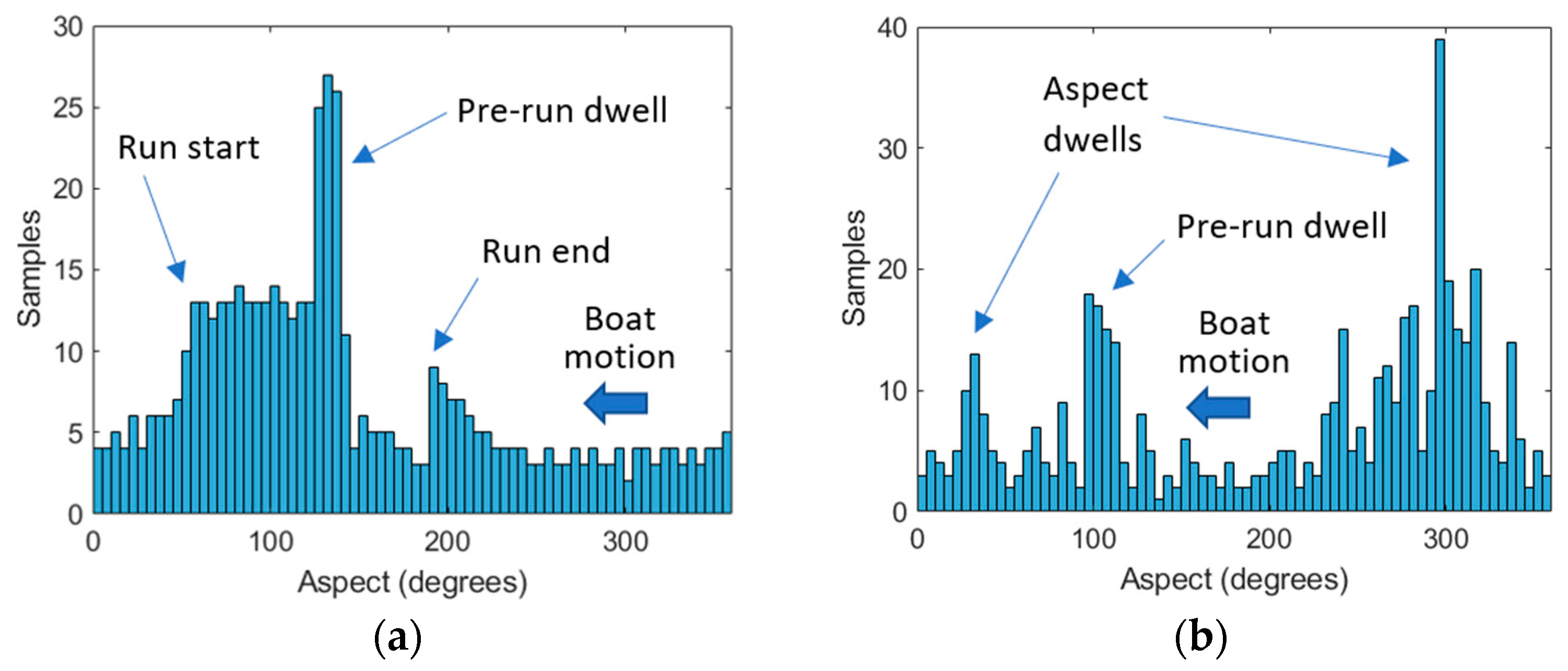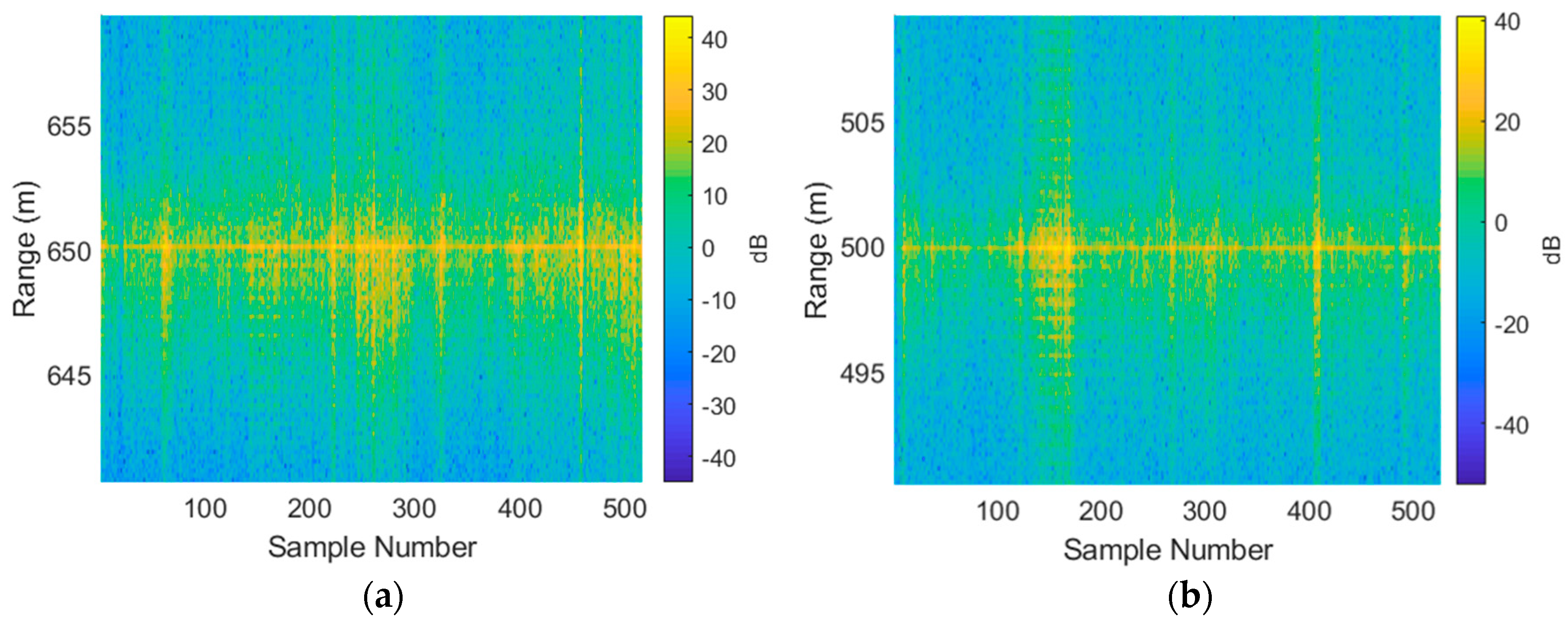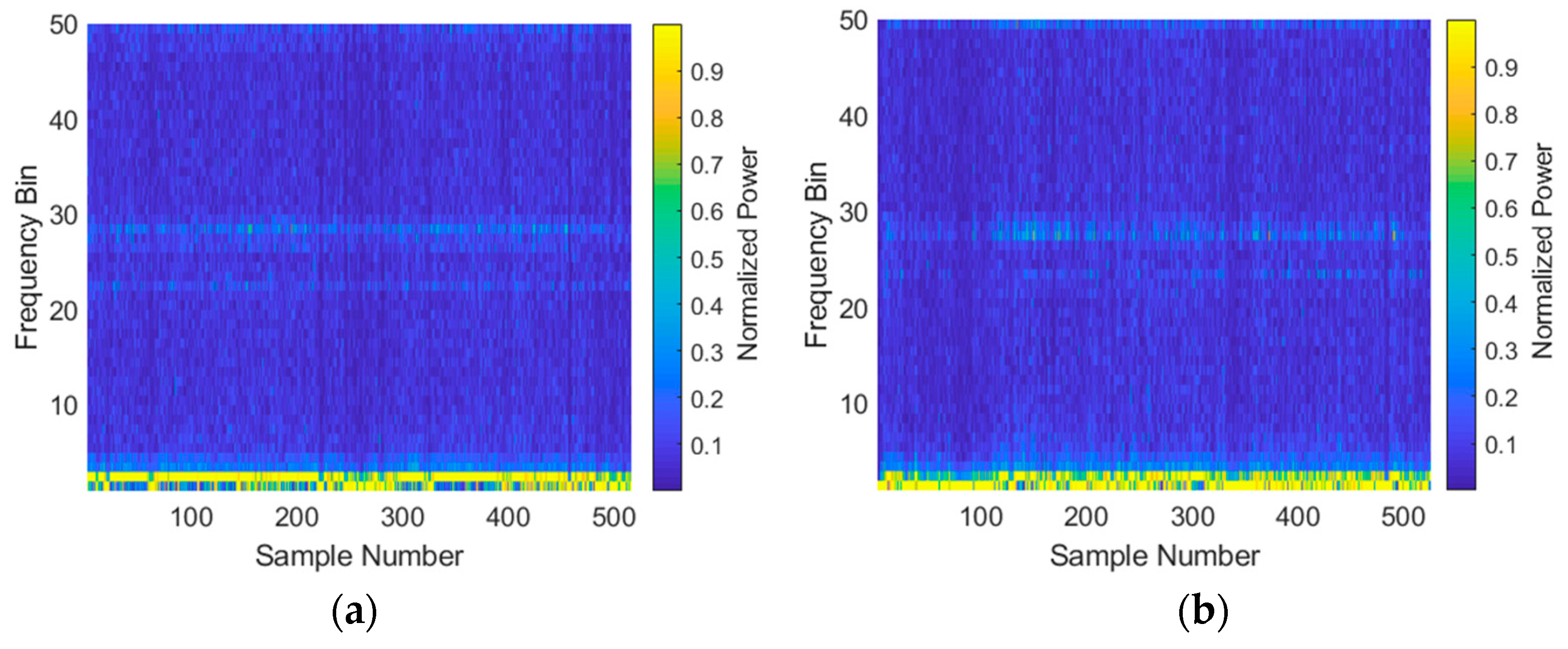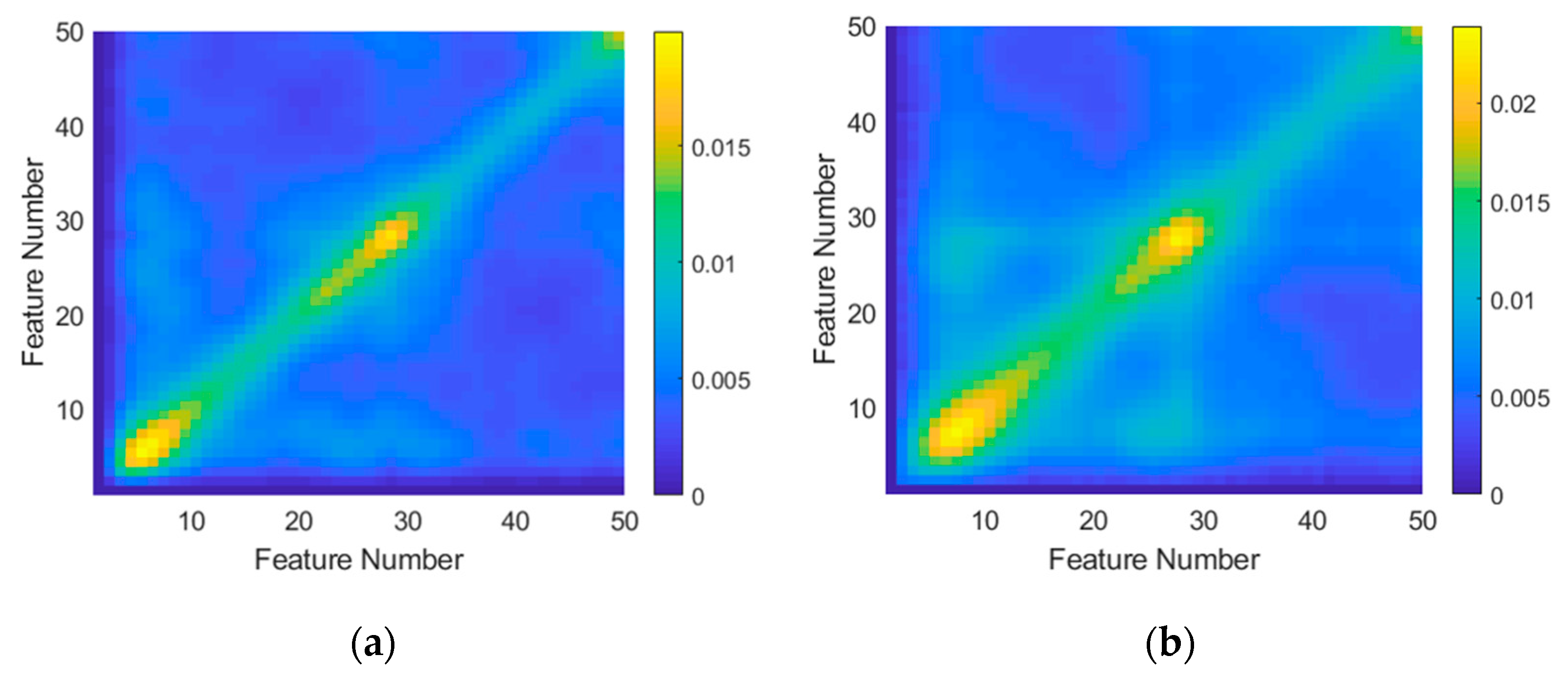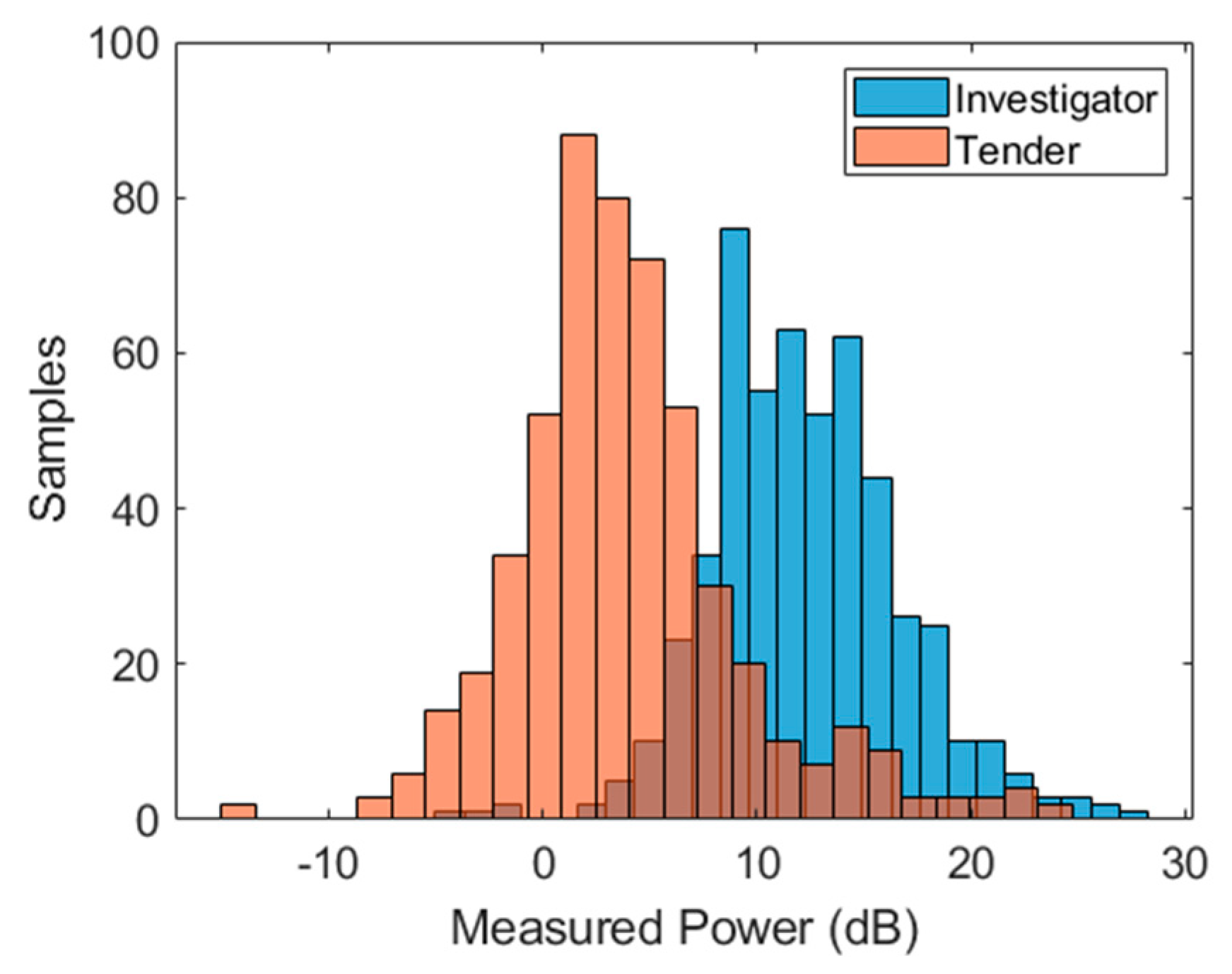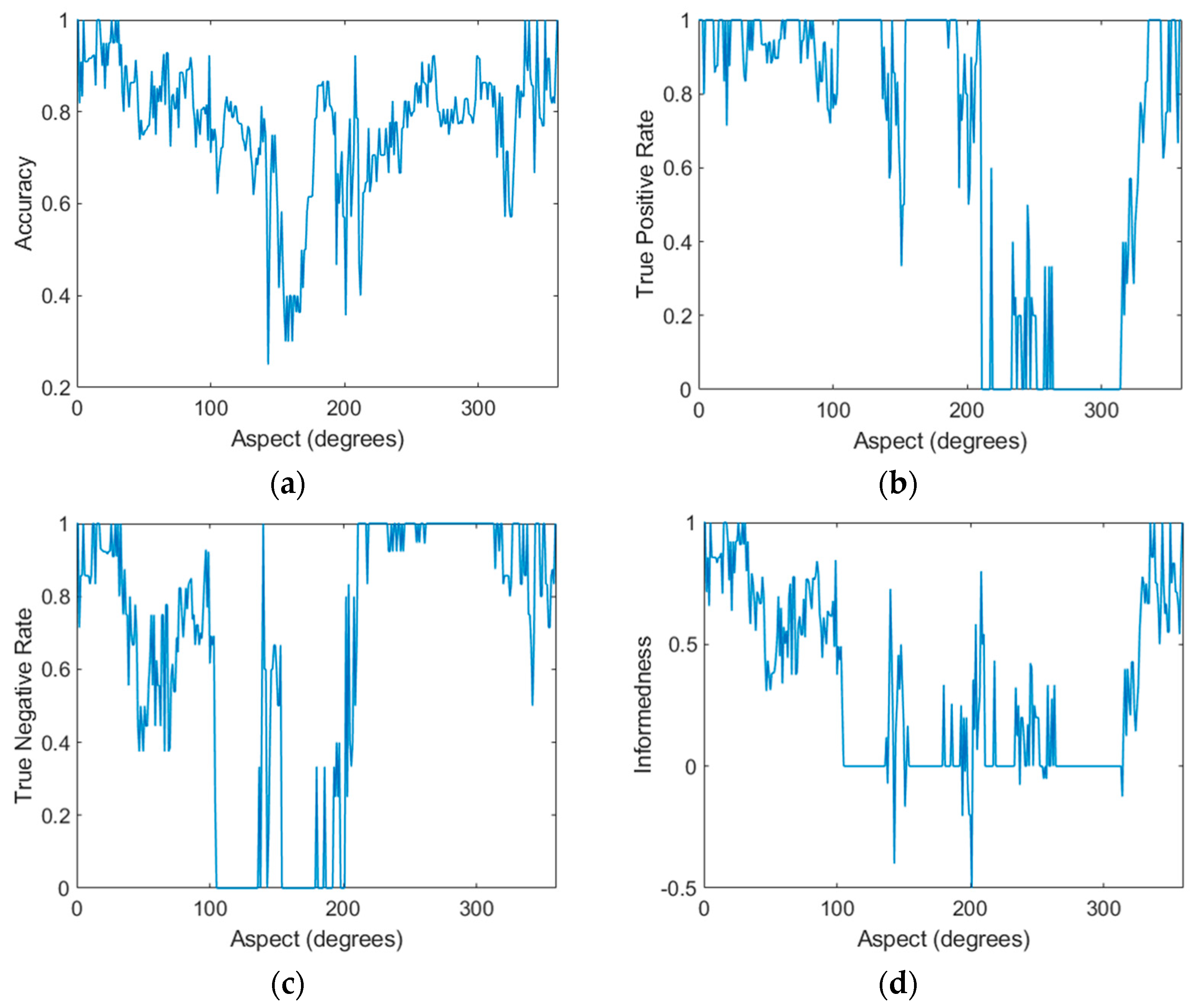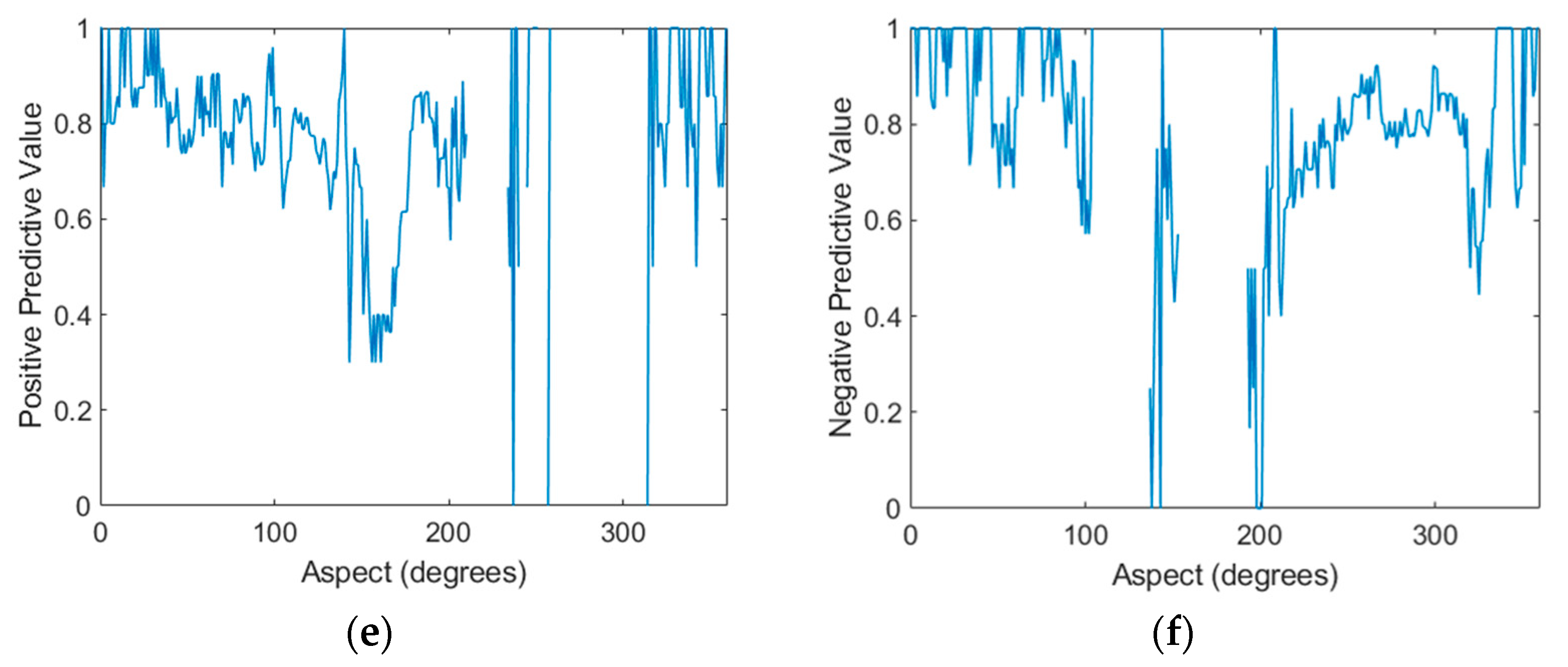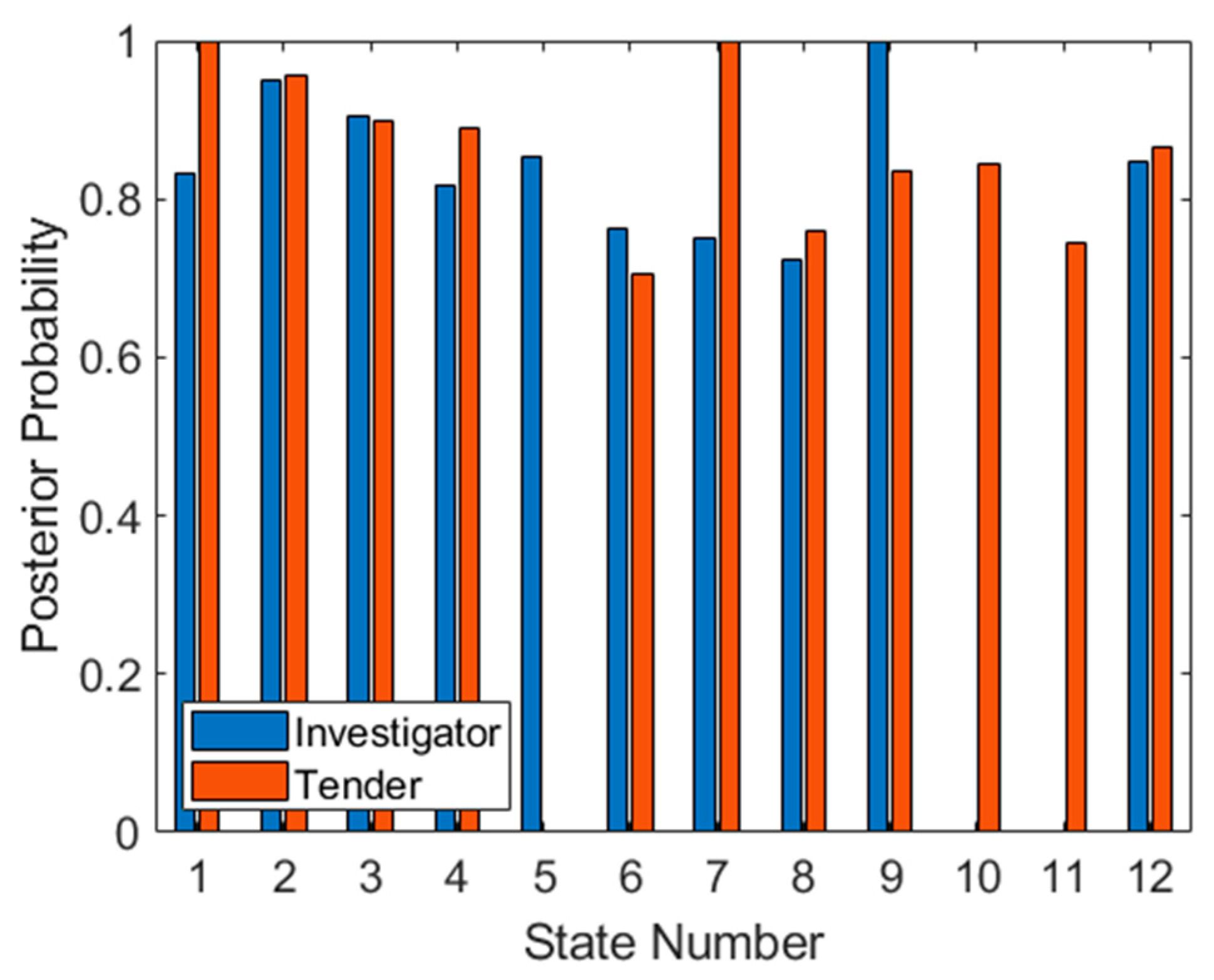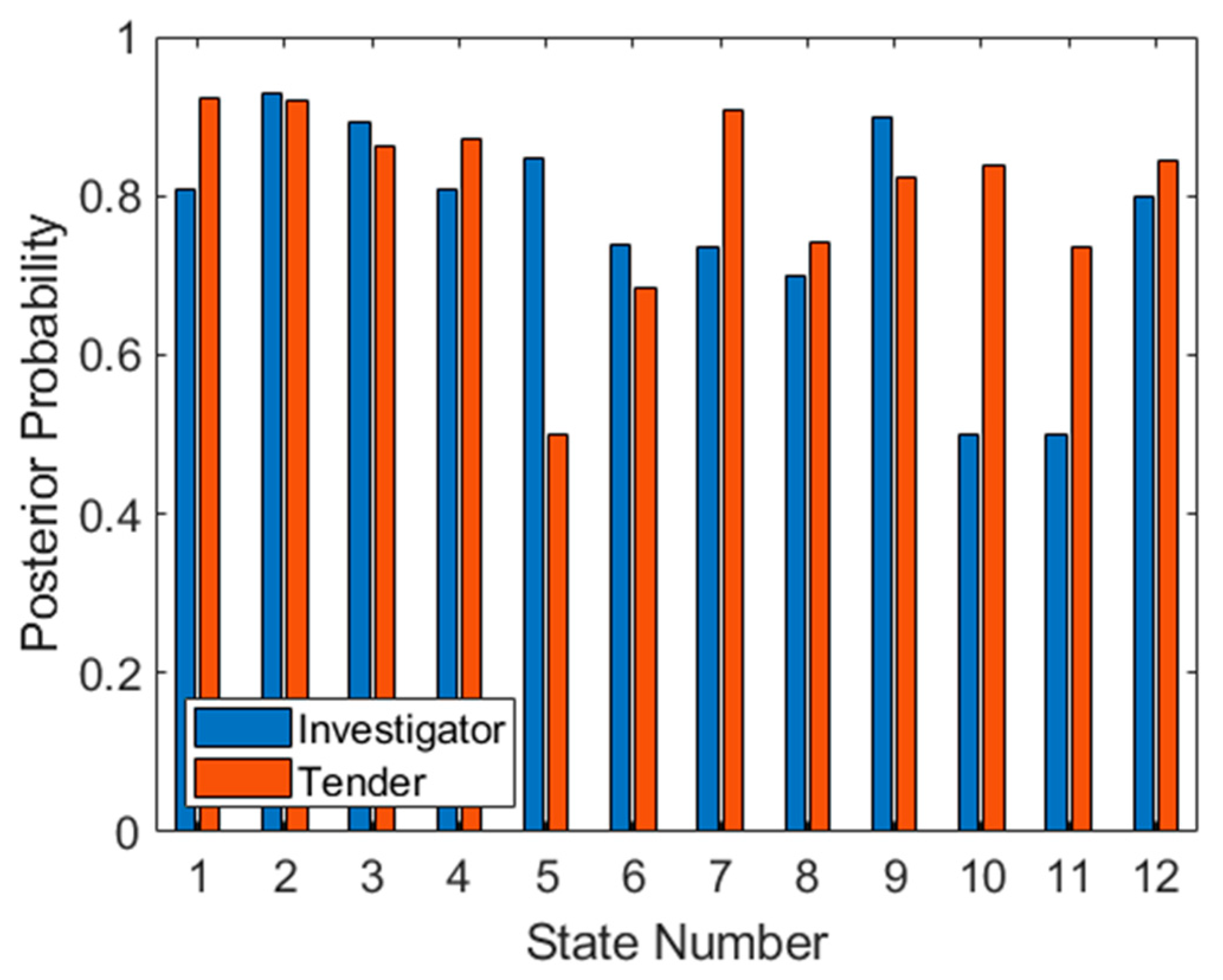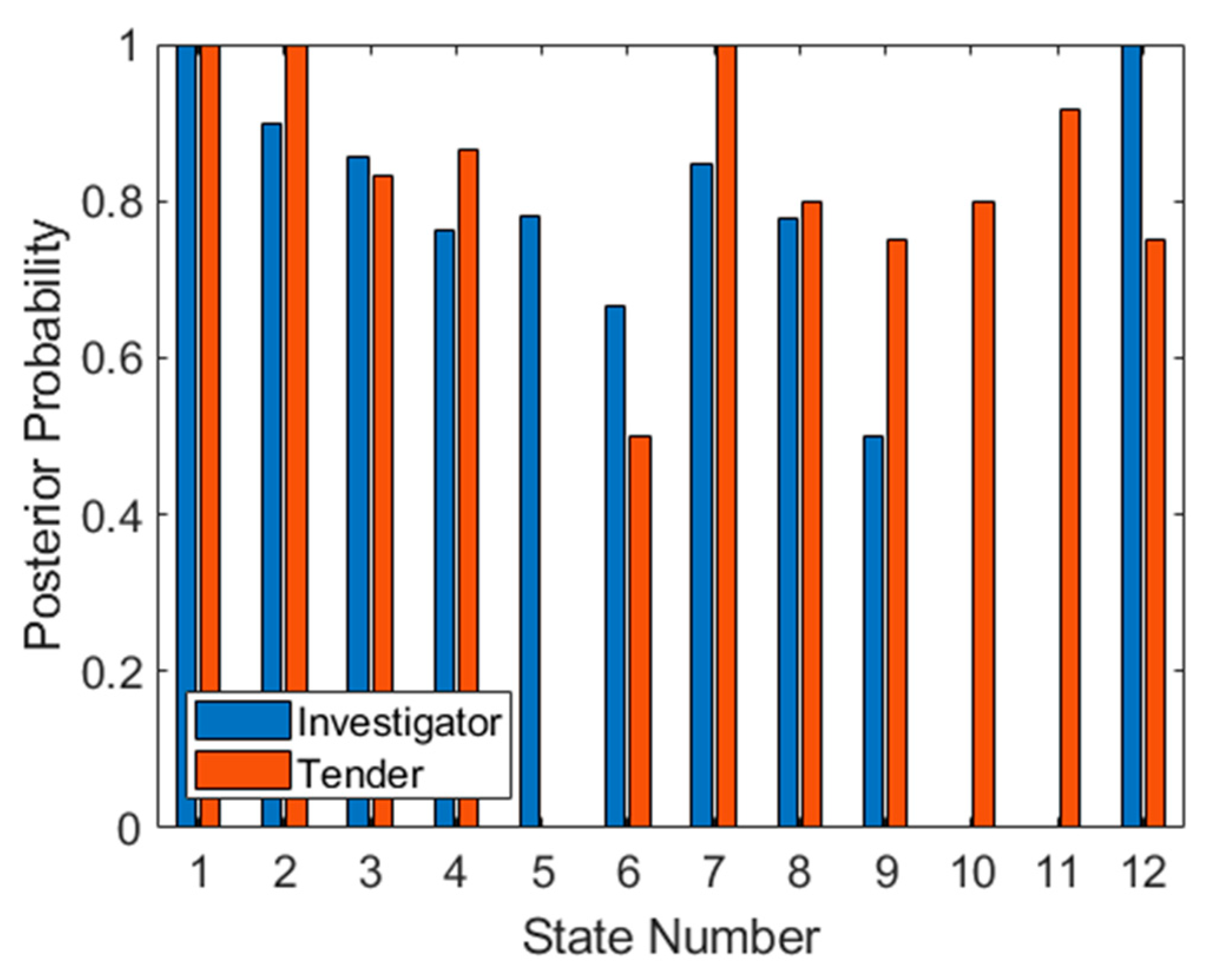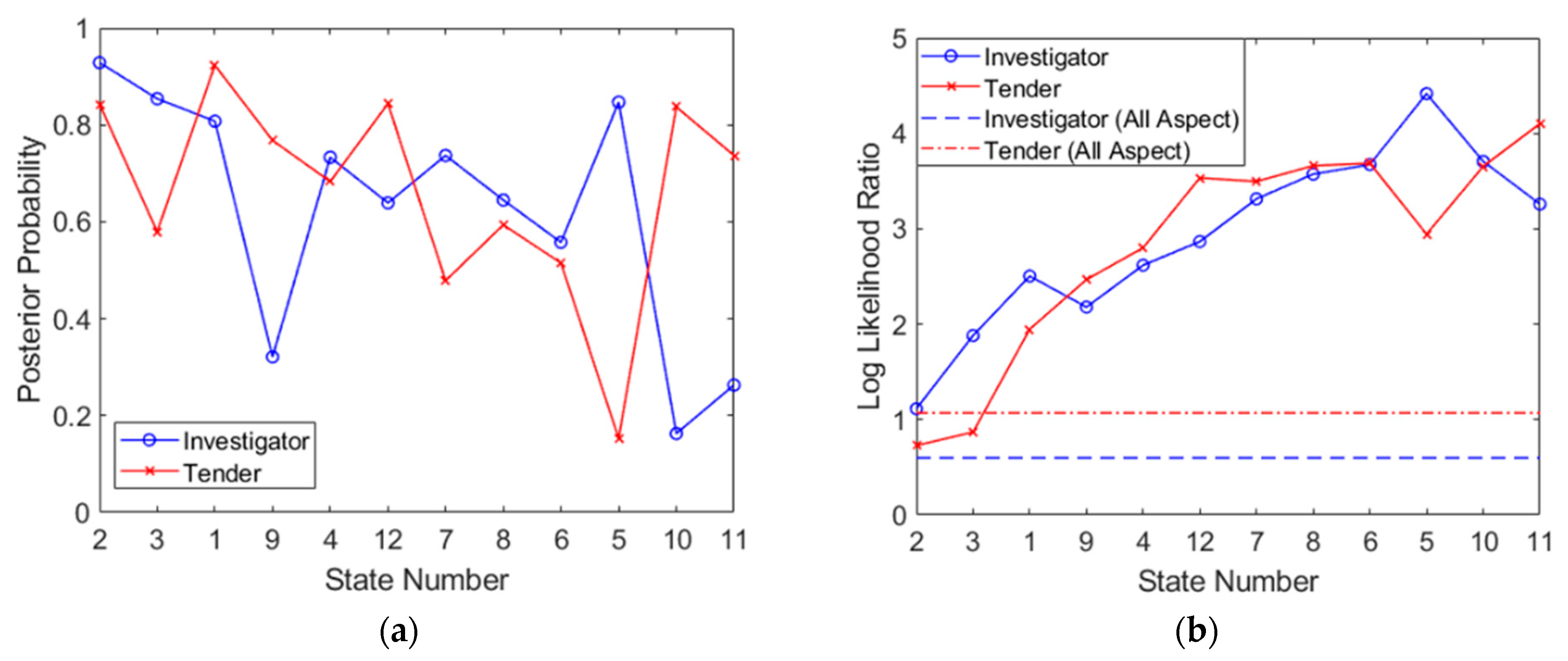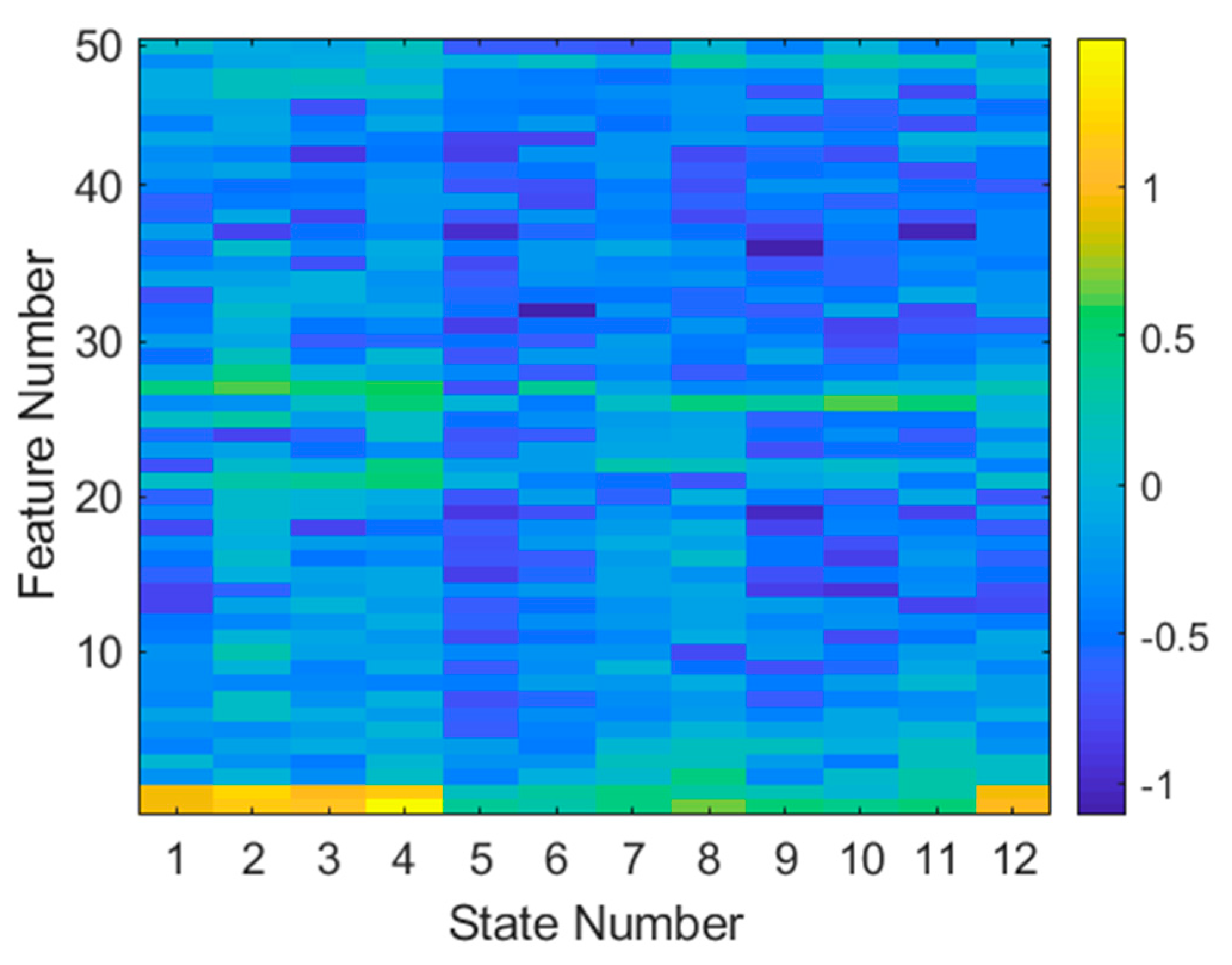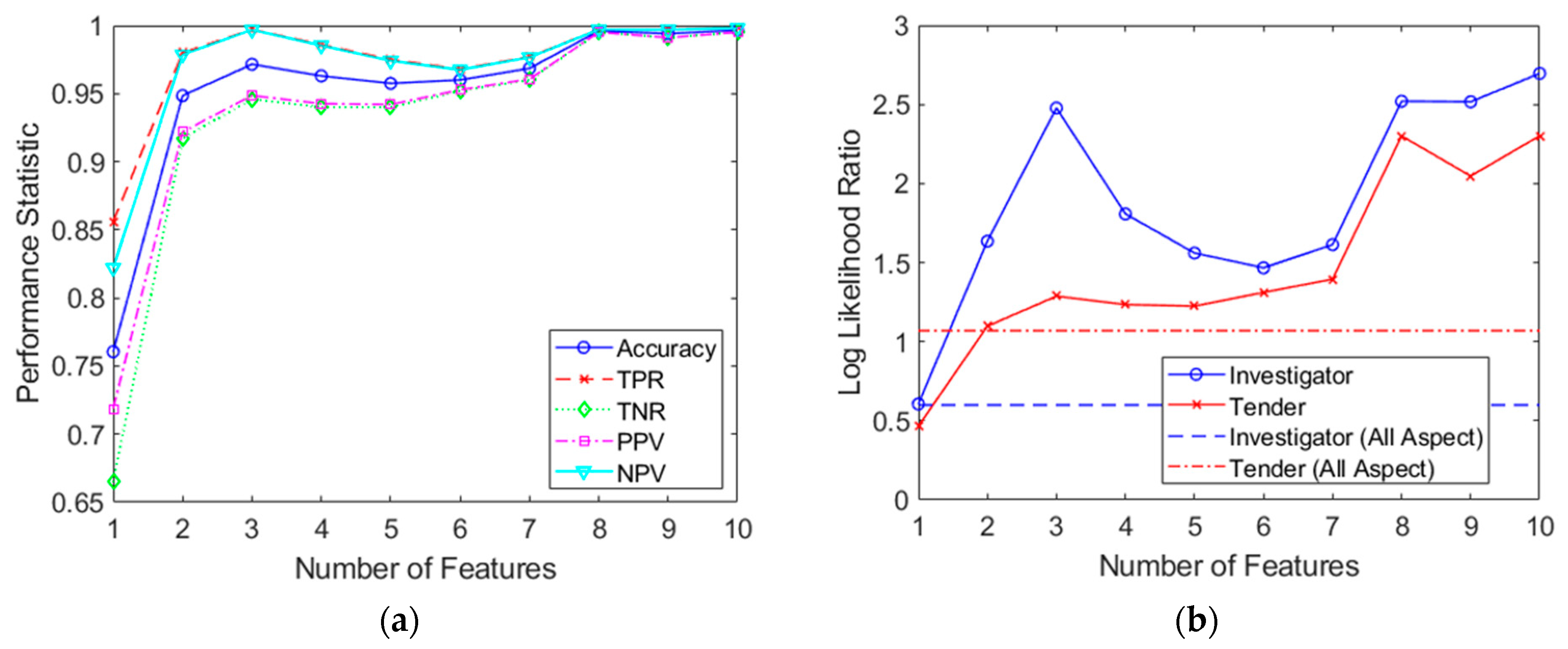The first multiaspect classification attempt was the most intuitive one, dividing the full dataset into sectors and performing classification on each sector independently. This approach can be considered as independent since the outcome at each sector is independent of any other sector.
When conducting the multiaspect classification, it was apparent that the 1041 range profiles collected in total were insufficient for a high-fidelity classification with the small intervals (e.g., 5°) typically used in such applications. For this reason, the sector width was increased to 30° so that each classifier had adequate data for thorough training and testing. The trade off in this approach was that each dataset consisted of data with more dramatic fluctuations, making the classification more challenging for the classifier. Furthermore, the holdout was increased from 5% to 25% so that adequate data were available for testing.
The positive predictive value (PPV) gives the ratio of correctly classified Investigator samples to all Investigator classifier outcomes, while the negative predictive value (NPV) gives the ratio of correctly classified Tender samples to all Tender classifier outcomes. These metrics will be important further in this paper when considering transition probabilities for both target types.
In terms of accuracy, 100% accuracy was achieved within the 335–35° range. Good accuracy was also achieved in the 60–105° and 220–305° ranges. Accuracy was generally highest when the target was imaged along its length.
There were aspects at which the TPR and TNR fell to zero (and rose to one for the other target), indicating that the classifier always selected one target type. This clearly represents aspects that fail to achieve any level of worthwhile classification. This is best illustrated in the informedness plot by the regions where informedness falls to zero (i.e., the classifier does not provide any information) or lower. These problematic aspects were: 100–130°, 155–190°, 210–230°, and 260–305°. Generally, these sectors represent aspects where the target was broadside or stern (rear) to the radar. Conversely, and consistent with the accuracy plot, it was the aspects from 0–100° and 310–0° that resulted in high informedness. This finding confirms that multiaspect imaging is highly dependent on aspect and identifies a particular set of aspects that are worthwhile for classification. A total of 54% of aspects (those aspects where informedness was positive) were effective for target classification given this particular dataset, preprocessing scheme and classifier.
Combining Observations
In order to apply the SVM classifier developed in the previous section to dynamic multiaspect scenarios, target observation probabilities, P(X|O), for each target at each target aspect are required. These are required not only to determine the final, multiaspect target probability (using the sum or product rules described later in this section) but also to provide a mechanism for prioritizing aspects where the classifier is most likely to achieve correct classification.
Unfortunately, the SVM classifier does not inherently provide an output in terms of a probability. The distance to the SVM hyperplane in feature space is generally not regarded as a reliable measure. One common solution is fitting a logistic function using logistic regression to the training sets and then applying the function to each test point. This approach relies on parameterization of the dataset which may not be effective for such a small amount of data. Ideally, a nonparametric approach is sought here.
We propose using the training set statistics directly—specifically, the true positive rate (TPR) and true negative rate (TNR) defined in Equations (2) and (3) to generate observation probabilities, and the positive predictive value (PPV) and negative predictive value (NPV) defined in Equations (8) and (9) to generate posterior (target) probabilities.
For the Investigator target, the observation probabilities are therefore:
and for the Tender target, the observation probabilities are:
where
n is the target aspect or state, and TP, FP, TN and FN are the true positive, false positive, true negative and false negative statistics for the corresponding target and target state or aspect.
Intuitively (or using Bayes rule), the posterior (target) probabilities for Investigator are:
and for Tender target, the posterior (target) probabilities are:
This approach assumes that the linear SVM will misclassify not only test points, but also training points, implying that it may be more effective using a “weak” classifier when implementing multiaspect classification. A linear SVM in high-dimensional hyperspace may fit this requirement well.
Figure 9 shows the posterior probabilities for each of the targets at each aspect, using the training set to obtain PPV and NPV statistics. These posterior probabilities indicate the probability that the classifier will correctly classify each target at each aspect (i.e., the ideal plot would have all values at unity, with no misclassifications).
While some aspects are not appropriate for classification (such as 5, 10 and 11) the other aspects (such as 1, 2, 3, 4, 6, 7, 9 and 12) promise reliable classification as well as high target probabilities.
One problem evident in the posterior probabilities in
Figure 9 is that there are probabilities at zero and one. Both numbers are unrealistic and will cause problems when later using the product or sum rules to accumulate probabilities. The solution employed here, which is common to this type of problem, is applying additive (or Laplace) smoothing to the data. The general form of this method is:
where
is the smoothed probability for class
i;
xi is the data to be smoothed (in this case PPV × (TP + FP) for Investigator and NPV × (TN + FN) for Tender, both corresponding to training data only);
N is the number of samples (in this case TP + FP for Investigator and TN + FN for Tender, again only corresponding to training data);
α is the smoothing parameter (in this case one) and
d is the total number of classes (in this case two). The result of this operation on the training data in
Figure 9 is shown in
Figure 10. Unusually, the zero probabilities of states 5, 10 and 11 have been now raised to 0.5. However, on further inspection, this is caused by no negative (i.e., Tender) classifications in the training set for state 5, and no positive (i.e., Investigator) classifications on states 10 and 11, so NPV and PPV statistics cannot be generated and the probability can only be a random guess (or the prior probability).
Once the posterior probabilities have been obtained for both targets at all aspects, it is possible to prioritize aspects based on expected classifier performance. Although there are several metrics for achieving this, in this case we have simply multiplied the smoothed observation probabilities together at each aspect, and sorted from the highest product to the lowest. This results in an optimal aspect sequence of 2, 3, 1, 9, 4, 12, 7, 8, and 6. The final three aspects (5, 10 and 11) have been omitted since one class at each of these aspects has a posterior probability of 0.5, and therefore these aspects are not any better than random guessing (for at least one target). Once again, this metric is somewhat arbitrary and depends on the application. In fact, one of the benefits of this approach which has not been exploited here, is that probabilities from different aspects can be combined, through selection of aspects, to obtain the desired receiver operating characteristic (ROC) statistics, depending on the objective of the classification (for example, minimizing false positives from a particular target).
The test set has been applied to the trained SVM in
Figure 11, firstly as a method of confirming that the observation probabilities are reliable. The similarity of both plots (the training set in
Figure 9 and the test set in
Figure 11) suggests that the datasets are indeed identically distributed. It is also possible to use the test set to predict how well the derived sequence will work. As seen in
Figure 9, aspects 5, 10 and 11 are ineffective for classification since one target type cannot be classified. If we apply the previously determined optimal sequence to the data in
Figure 11, we see that for the first three aspects (2, 3 and 1), classification of both targets is correct (assuming that all available test data are considered). However, at aspect 9, a posterior probability of 0.5 is achieved for Investigator. For the next four aspects (4, 12, 7 and 8) classification performance is well above 0.5 for both targets. Finally, for the last prioritized aspect (6), the posterior also falls to 0.5 for the Tender target, making this aspect ineffective.
We can therefore conclude that when using this technique, aspects should be prioritized using the products of their posterior probabilities. To achieve a monotonically increasing target probability (assuming use of the product rule to combine posterior probabilities across aspects, discussed later in this section), the best three (out of twelve) aspects should be used. Otherwise using all nine valid prioritized aspects will also provide further gains but the process will involve more measurements from more aspects. However, in this case because of 0.5 posteriors at two aspects, this accumulated target probability will not improve when transiting these aspects, so confidence in target class will increase more slowly.
We thus obtained the necessary posterior (target) probabilities for both targets across all states, providing us with an optimized sequence of aspects and a valid test set. The problem now becomes combining classification results to achieve a confidence measure.
There are many options for combining classification results. Two common approaches are the sum and product rules. The sum rule is better suited to dependent feature spaces, with potentially large errors. The product rule is preferable when classifiers have small errors and are operating in independent feature spaces [
42]. In this paper, we will therefore use the sum rule for combining probabilities within a single aspect (where observations are likely to be dependent and fluctuations may be high) and we will use the product rule to combine probabilities between aspects (where measurements may be regarded as somewhat independent and errors are small).
We define the sum rule in this context as:
where
P(
X|
Op) is the combined posterior (target) probability for state
p, and
P(
X|
On) are the target posterior probabilities from
Figure 10, and
are the set of smoothed target posterior probabilities indexed by the classifier output, corresponding to class
i for
N available test points. This calculation was repeated for both targets and all aspects.
We defined the product rule in this context as:
where
P(
X|
O) is the multiaspect, combined posterior (target) probability for
P states or aspects, normalized for targets
x = 1,2.
P(
X|
Op) is the single-aspect target posterior probability obtained by the sum rule. This calculation is repeated for both targets,
x = 1,2.
The posterior probabilities obtained from the product rule,
P(
X|
O), are cumulative and with each subsequent aspect can become extremely large. For the purpose of visualization, these are expressed as log-likelihoods. Furthermore, in order to avoid the normalization step, they are expressed as likelihood ratios (the ratio of the likelihood of the correct target to the likelihood of the incorrect target). The log-likelihood ratio can be written as:
where
X represents the correct class and
¬X represents the incorrect class (when referring to confusion matrices, this is calculated as LLR
I = log(PPV) − log(FOR) for Investigator and LLR
T = log(NPV) − log(FDR) for Tender, where FOR is the false emission rate, FOR = FN/(FN + TN) and FDR is the false discovery rate, FDR = FP/(FP + TP)), calculated for both targets. The results of both the sum rule (combining results within a single aspect) and the product rule (combining results from multiple aspects) expressed as a log-likelihood ratio, are shown in
Figure 12. These plots have been generated according to the optimized aspect sampling order, as previously detailed. The gradual decrease in target probabilities in
Figure 12a confirms that the highest value aspects are indeed sampled first. It should be noted that
Figure 12a differs from
Figure 11 since it does not utilize test set statistics; these calculations rely on training set statistics, indexed by test set results as they are obtained (as would be the case in a real classification). All available test points at each aspect have been utilized (and the final three poorly performing aspects have also been included for completeness).
Figure 12b shows the progression of the log-likelihood (which can be seen as a confidence measure of each class) through measurements at successive aspects. In order to compare performance to traditional, full dataset classification, log-likelihoods have also been generated from data in
Table 3 (full dataset, all-aspect SVM classification) as a reference. The log-likelihood exceeds that of the full dataset classifier for both targets at the third aspect and beyond. By the final state, the performance benefit is about 2.7 (or 500-fold) for Investigator and about 3.0 (or 1000-fold) for Tender. This is a result that favors multiaspect classification but relies on the assumption (required of the product rule) that measurements from different aspects are independent, which may not be necessarily true since radar measurements of a target from different aspects are clearly correlated to some extent. This is the problem that we will attempt to address next. A summary of the multiaspect SVM procedure is shown in Algorithm 1.
| Algorithm 1: Multiaspect SVM |
| Input: Preprocessed radar training data |
| Output: Log-likelihood ratio (LLR) for each target |
| |
| TRAINING: |
| for i:M aspects do |
| Perform training of SVM: wi, bi |
| Compute target probabilities, Pi(X|O) from PPV and NPV statistics |
| Carry out Laplace smoothing: |
| end for |
| Sort aspects from highest value to lowest value |
| |
| TESTING: |
| Determine aspects required for data collection: N |
| for i:N aspects do |
| for j:P testPoints do |
| Make radar measurement |
| Preprocess data: x |
| Perform classification: h(x) |
| Lookup Pj(X|O) from training data for each target |
| Apply sum rule to determine average Pi(X|O) for each target |
| end for |
| Apply product rule to determine aggregate: P(X|O) for each target |
| Update LLR |
| end for |

